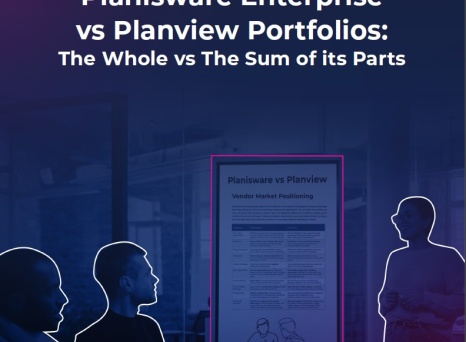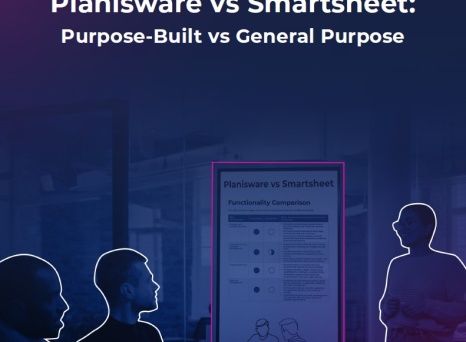A synthesis of 18 benchmark reports from five leading IT analyst firms, providing an independent ranking and market perspective on c.80 project software solutions.
Introduction
This in-depth article presents the findings of Planisware’s meta-analysis across 18 authoritative reports spanning the full breadth of the modern project software landscape, including Enterprise Project and Portfolio Management (PPM/EPPM) and Strategic Portfolio Management (SPM) solutions for both enterprise and mid-market segments. The analysis draws exclusively from the research of five leading, globally recognized industry analyst firms: Gartner, Forrester, IDC, Info-Tech, and GigaOm.
The strength of this methodology lies in leveraging analyst firms that operate as objective, independent observers of the market. By aggregating multiple cycles of benchmarking and evaluation, this meta-analysis identifies solutions recognized for consistent enterprise adoption and the ability to maintain prominent analyst attention across evolving industry criteria and business needs.
Furthermore, by synthesizing research across analysts with diverse coverage areas and client bases, this review mitigates the impact of any single firm’s market segmentation or regional focus. The outcome is a data-driven, panoramic perspective of a fragmented and highly competitive software market. It gives business leaders, IT strategists, and project executives a credible foundation for technology selection and market insight.
Methodology
Disclosure: This analysis is published by Planisware for the purpose of independent market intelligence. While Planisware is among the evaluated vendors in the source studies, the methodology applies consistent, impartial criteria across all vendors to ensure objectivity and transparency in the assessment.
This meta-analysis consolidates information from 18 studies in the domains of Project and Portfolio Management (PPM), Enterprise Project and Portfolio Management (EPPM), Strategic Portfolio Management (SPM), and Agile project solutions. These studies were authored by five of the world’s leading analyst firms: Gartner (representing over half of the reports in scope), Forrester, IDC, Info-Tech, and GigaOm. See the full list of studies in the Validation Resources section below.
Across these reports, a total of c.80 software vendors were evaluated. Each vendor’s presence and placement was systematically recorded in a central analysis matrix (available in the Validation Resources section). When applicable, vendors’ positions were classified across four ranks with an associated score: Leader (20), Major Player (10), Strong Performer (10), and Contender (5). In certain studies, there is no placement, in such cases all vendors are assigned a score of 5.
To reflect both industry recognition and solution prominence, 3 scores were computed:
- Frequency Count: Measures the number of times each vendor is featured in a study.
- Average Score: average score based on the vendor’s placement (e.g., Leader, Major Player) within each report.
- Impact Score: from the direct metrics gathered from the studies, we computed an Impact score that combines the occurrence of vendors in the studies and their average score. This synthetic Impact Score combines both the breadth of market visibility and depth of analyst endorsement, providing a holistic gauge of each vendor’s maturity and strategic influence.
The study set prioritizes recency for greater market relevance, with 11 of the 18 reports published since 2023. Rapid evolution, mergers, and acquisitions are intrinsic to the project software industry; While this page only includes vendors still actively operating as of publication, the analysis covers all vendors.
Where a vendor such as Planview appeared with multiple product lines, reflecting significant acquisition activity (e.g., over a dozen products in recent years), only the highest-ranked individual solution was factored into placement calculations to avoid skewing results.
Within each tier, vendors are listed in alphabetical order.
Definitions
PPM
Project and Portfolio Management (PPM) encompasses processes and technologies that select, plan, execute, and monitor projects and related work packets, typically combining project scheduling, resource/cost management, and portfolio oversight to maximize value delivery against constraints.
Modern PPM spans classic execution‑level capabilities (time, resource, budgets, status) and portfolio‑level reporting, often integrating with agile tools, ERP/financials, and collaboration platforms to provide coherent visibility and governance across mixed delivery methods.
EPPM
Enterprise Program and Portfolio Management (EPPM) is the portfolio-centered discipline used by enterprise-level portfolio offices (e.g., EPMO - Enterprise Project Management Office, SRO - Strategy Management Office, TMO - Transformation Management Office) to govern strategy-to-outcome alignment, optimize investment mix, and run what‑if scenarios across programs, projects, and digital products without mandating task-level execution in the same tool.
EPPM emphasizes portfolio modeling, comprehensive dashboards, and scenario planning to adapt to shifting priorities while aggregating key signals from execution systems of record (agile, ITSM, ERP) for decision support at enterprise scale.
SPM
Strategic Portfolio Management (SPM) is an enterprise capability and tooling category that maintains strategy‑to‑execution alignment by connecting strategies, measurable outcomes, funding models, and element‑neutral portfolios (investments, products, capabilities, applications) with analytics for adaptive decisions across SEM (Strategy Execution Management), EPPM, and Agile use cases.
SPM supports definition/mapping of strategic elements, dynamic funding, demand and program management, portfolio roadmapping, resource what‑if analysis, and deep integrations with asset management systems (IT or otherwise), agile, workflows, ERP, and reporting systems to drive outcome‑centric planning and reprioritization.
Agile
Agile methodology refers to iterative, incremental work practices (e.g., Scrum, Kanban, SAFe) emphasizing short cycles, continuous feedback, prioritized backlogs, and cross‑functional teams to accelerate learning and value delivery under change.
At scale, agile requires portfolio‑level synchronization (objectives, funding guardrails, capacity, flow metrics) and supporting automation across planning, execution, and DevOps toolchains, often assessed alongside value stream practices in analyst evaluations.
Key Findings
Within tiers, vendors are listed in alphabetical order.
1st Tier: Market Dominants (Impact score > 241)
These vendors achieve the pinnacle combination of maximum analyst coverage and consistently top-tier performance. They are the undisputed market reference points for enterprise PPM and strategic portfolio management with both having offerings catering to enterprise as well as mid-market deployments.
Planisware - 18 studies, avg. score of 16
The enterprise specialist renowned for highly sophisticated project management across several project specialities: IT, Product development or PSA. Exceptional strength in advanced portfolio analysis, AI-driven planning, robust financial modeling, and deep industry verticalization. Distinguished by customer success management approach and configurable depth that scales with organizational maturity.
For reference, in addition to the analysis, Gartner Peer Insight scores (as of Nov. 4, 2025):
- SPM: 4.6 score based on 119 ratings - “Customer Choice 2024”
- PPM: 4.5 score based on 76 ratings
- APMR: 4.5 score based on 53 ratings
Planview - 18 studies, avg. score of 18
The comprehensive SPM leader combining strategic planning with enterprise architecture and agile-at-scale support. Demonstrates market-setting thought leadership, broad industry expertise, and continuous innovation in value stream management. Strong acquisition strategy creates end-to-end portfolio visibility from strategy to execution, albeit from a very broad set of solutions. Ideal for large enterprises pursuing integrated business architecture with strong financial planning requirements.
For reference, in addition to the analysis, Gartner Peer Insight scores (as of Nov. 4, 2025):
- SPM: 4.5 score based on 64 ratings
- PPM: 4.1 score based on 843 ratings
- APMR: 4.4 score based on 118 ratings
2nd Tier: Strong Performers (Impact score between 121 to 240)
Strong, consistent performers with substantial analyst recognition. These vendors represent credible enterprise alternatives with proven track records.
Broadcom (Clarity) - 12 studies, avg. score 15
The digital transformation specialist positioning Clarity within its ValueOps ecosystem. Excellent enterprise agile planning capabilities, strong resource and budget management, and highly visual roadmapping for digital products. Robust integration with development toolchains and emphasis on value stream optimization. Best suited for organizations scaling agile capabilities with existing enterprise architecture solutions.
For reference, in addition to the analysis, Gartner Peer Insight scores (as of Nov. 4, 2025):
- SPM: 4.5 score based on 41 ratings
- PPM: 4.3 score based on 186 ratings
- APMR: none.
Smartsheet - 11 studies, avg. score 13
The collaborative platform pioneer with flexible data models supporting diverse use cases. Strengths include intuitive user experience, extensive community-driven templates, and strong automation capabilities through Control Center and Bridge. Optimal for organizations preferring self-designed processes without heavy professional services investment.
For reference, in addition to the analysis, Gartner Peer Insight scores (as of Nov. 4, 2025):
- SPM: none
- PPM: 4.4 score based on 730 ratings
- APMR: 4.6 score based on 194 ratings - “Customer Choice 2025”
Wrike - 10 studies, avg. score 14
The productivity-focused collaboration platform with an advanced Work Intelligence suite. Delivers streamlined user experience, some AI-powered features such as risk prediction, and strong project collaboration across distributed teams. Recent architectural improvements enhance performance and usability. Best for mid-to-large organizations emphasizing team productivity and modern user experience.
For reference, in addition to the analysis, Gartner Peer Insight scores (as of Nov. 4, 2025):
- SPM: none
- PPM: 4.6 score based on 380 ratings
- APMR: 4.3 score based on 186 ratings
3rd Tier: Recognized Providers (Impact score between 5 to 120)
Notable blend of strong capability and analyst endorsement, though with different coverage patterns.
Atlassian - 7 studies, avg. score 11
The agile product portfolio specialist leveraging Jira Align for digital teams. Competent agile product support with strong integration to software development workflows, but limited in hybrid resource planning and top-down cost management. Ideal for agile teams with product portfolio requirements rather than enterprise strategic planning.
For reference, in addition to the analysis, Gartner Peer Insight scores (as of Nov. 4, 2025):
- SPM: none.
- PPM: none.
- APMR: none.
Bizzdesign (Alfabet) - 5 studies, avg. score 20
The enterprise architecture powerhouse combines Enterprise Architecture (EA) with strategic portfolio management. Exceptional strength in IT portfolio analysis, compliance management, and complex transformation orchestration. Integration of EA capabilities differentiates for technical transformations but may limit appeal to business stakeholders. Best for IT-strategy-driven organizations managing complex digital transformations.
For reference, in addition to the analysis, Gartner Peer Insight scores (as of Nov. 4, 2025):
- SPM: 4.4 score based on 42 ratings
- PPM: none.
- APMR: none.
Microsoft - 8 studies, avg. score 9
The platform giant offering integrated Project solutions within the Office 365 ecosystem. Broad accessibility and familiar interfaces, but consistently underperforms in specialized PPM/SPM capabilities relative to dedicated solutions. Suitable for organizations prioritizing platform consolidation over PPM excellence.
For reference, in addition to the analysis, Gartner Peer Insight scores (as of Nov. 4, 2025):
- SPM: none.
- PPM: 4.3 score based on 980 ratings
- APMR: none.
Monday.com - 6 studies, avg. score 15
The visual work management platform with strong collaborative features and intuitive interface. Rapid growth in non-technical markets with flexible project views and automation. Limited enterprise-scale capabilities and strategic portfolio management depth. Optimal for creative teams and collaborative work management rather than complex portfolio analysis.
For reference, in addition to the analysis, Gartner Peer Insight scores (as of Nov. 4, 2025):
- SPM: none.
- PPM: 4.5 score based on 270 ratings
- APMR: 4.5 score based on 299 ratings - “Customer Choice 2025”
Planforge - 5 studies, avg. score 13
The enterprise agile specialist (formerly ONEPOINT Projects) with strong SAFe support. Loyal customer base values technical support and configurability for agile frameworks. Limited geographical presence and slower innovation cycles. Best suited for organizations with specific agile transformation requirements.
For reference, in addition to the analysis, Gartner Peer Insight scores (as of Nov. 4, 2025):
- SPM: none.
- PPM: 4.3 score based on 35 ratings
- APMR: 4.7 score based on 13 ratings
ServiceNow - 7 studies, avg. score 16
The platform integrator combines SPM with IT service management on the Now Platform. Strong value proposition through a common service data model connecting strategic planning with operational execution. Lengthy implementations but powerful integration capabilities. Interesting option for existing ServiceNow customers seeking portfolio management integration with enterprise IT management.
For reference, in addition to the analysis, Gartner Peer Insight scores (as of Nov. 4, 2025):
- SPM: 4.3 score based on 76 ratings
- PPM: 4.3 scores based on 164 ratings
- APMR: none.
TeamDynamix - 4 studies, avg. score 20
The specialized solution achieves perfect analyst scores but in a limited number of evaluations. Strong niche performance suggests excellence in specific verticals or use cases, likely higher education or specialized service organizations. Limited broader market presence indicates focused rather than enterprise-wide applicability.
For reference, in addition to the analysis, Gartner Peer Insight scores (as of Nov. 4, 2025):
- SPM: none.
- PPM: none.
- APMR: none.
Key Insights from Weighted Ranking Analysis
This landscape provides an insightful analysis of the PPM market's competitive hierarchy, revealing both the persistence of specialized leaders and the dynamic of the market.
Ranking vs. Frequency Divergence
The proposed scoring methodology demonstrates:
- Pure-play advantage: Pure-play project software vendors (Planisware, Planview) maintain top positions because when they appear in studies, they frequently achieve "Leader" or "Strong Performer" status.
- Platform penalty: Broad enterprise platforms (ServiceNow, Microsoft, Atlassian) may appear frequently but often in "Strong performer" or "Contender" positions within evaluations, reflecting their multi-domain focus.
- Execution excellence: Broadcom, Smartsheet, and Wrike's weighted ranking elevation suggests they consistently achieve high placement when evaluated, indicating strong execution capabilities.
Surprises and Market Implications
Expected Confirmations
- Planisware/Planview dominance aligns with industry expectations for vibrant SPM/PPM specialists
- Monday.com, Asana, Wrike emergence reflects the collaborative work management convergence trend
- Microsoft, ServiceNow, Atlassian frequency confirms their platform ubiquity, even if PPM isn't their primary strength
Notable Observations
- ServiceNow's position drop: Despite frequent study inclusion, its positioning as a platform play rather than SPM/PPM specialist impacts rankings—this suggests analysts view it as complementary rather than competitive to pure-plays.
- Smartsheet's consistent performance: Its strong weighted ranking relative to frequency suggests excellent execution when competing directly in SPM/PPM evaluations.
- Adobe's declining trajectory: Present in frequency counts but lower weighted scores may indicate market share challenges or strategic pivot away from SPM/PPM.
Long Tail Validation
The sizable vendor list (c.80 vendors) included in at least one analysis, confirms the market's extreme fragmentation while highlighting that sustained analyst attention is reserved for ~20-25 solutions. The presence of niche players (Deltek, Primavera, Oracle, SAP, HCL/IBM) in few studies reflects their vertical market strength rather than broad market leadership.
Strategic Implications for Enterprise Buyers
For C-Level Decision Makers
- Tier 1 vendors represent the "must consider choices" for enterprise SPM/PPM transformation with proven track records
- Tier 2 vendors offer platform integration advantages and may be optimal for organizations seeking PPM as part of broader digital workplace strategies
- Tier 3 and specialized vendors provide best-of-breed solutions for specific industries, regions, or use cases
Market Evolution Indicators
Data suggests the project software market is bifurcating between:
- Strategic portfolio specialists (Planisware, Planview) maintaining leadership.
- Collaborative work platforms (Monday.com, Smartsheet, Wrike, Asana) focusing on business-user adoption.
- Enterprise platform extensions (ServiceNow, Microsoft, Atlassian) providing integrated PPM capabilities.
This analysis provides insight into the current market dynamics and offers enterprise buyers a data-driven framework for vendor evaluation based on both analyst consensus and performance consistency across multiple evaluation cycles.
Disclaimer and Limitations of this study
This meta-analysis is provided for informational purposes only. It is based on third-party analyst reports and public information compiled and interpreted by Planisware. While care has been taken in the selection of sources and the synthesis of findings, the analysis does not constitute an endorsement, warranty, or guarantee by Planisware regarding the completeness, timeliness, or accuracy of the information presented. The study is not exhaustive and may omit relevant vendors, studies, or developments. Any decisions made on the basis of this material are the sole responsibility of the reader. Planisware reserves the right to update or amend the content without prior notice.
This meta-analysis provides a consolidated perspective based solely on vendors that have received coverage from major industry analyst firms. As a result, the findings capture only a segment of the overall project software landscape, potentially omitting innovative or emerging vendors who have not been included in mainstream analyst research.
While the weighting methodology has been applied consistently across all vendors to ensure fairness, it nonetheless reflects a single analytical viewpoint and may not address all nuances. Alternative scoring models or qualitative factors might yield different vendor rankings.
Finally, regional and niche market dynamics, such as country-specific regulatory environments or highly specialized industry needs, may not be fully addressed or represented in this study. Readers should consider these findings as one perspective among several, and are encouraged to supplement with additional research tailored to their specific context and requirements.
Validation resources
List of studies that are part of this market intelligence report
- Magic Quadrant for Project and Portfolio Management, Gartner, 21 May 2019
- Market Guide for Adaptive Project Management and Reporting, Gartner, 19 July 2021
- Forrester Wave: Strategic Portfolio Management Tools, Forrester, 14 Feb. 2022
- Magic Quadrant for Adaptive Project Management and Reporting, Gartner, 22 Aug. 2022
- Magic Quadrant for Strategic Portfolio Management, Gartner, 18 Apr. 2022
- Emotional Footprint Report / Project Portfolio Management - Enterprise, Info-Tech, Aug. 2022
- Data Quadrant Report / Project Portfolio Management, Info-Tech, Feb. 2022
- Magic Quadrant for Adaptive Project Management and Reporting, Gartner, 5 Sept. 2023
- Magic Quadrant for Strategic Portfolio Management, Gartner, 25 April 2023
- Voice of the Customer for Strategic Portfolio Management, Gartner, 29 Sept. 2023
- IDC MarketScape: Worldwide Strategic Portfolio Management and IT PPM 2023-2024 Vendor Assessment, IDC, Dec. 2023
- IDC MarketScape: Worldwide Value Stream Management and Agile PPM 2023-2024 Vendor Assessment, IDC, Dec. 2023
- Magic Quadrant for Adaptive Project Management and Reporting, Gartner, 4 Sept. 2024
- Magic Quadrant for Strategic Portfolio Management, Gartner, 28 May 2024
- GigaOm Radar for Agile Planning & Portfolio Management (PPM), GigaOm, 6 June 2024
- Magic Quadrant for Strategic Portfolio Management, Gartner, 4 Aug. 2025
- Emotional Footprint for Project Portfolio Management - Enterprise (PPM) Software, Info-Tech, consulted 11 Sept. 2025
- Data Quadrant for Project Portfolio Management - Enterprise (PPM) Software, Consulted 11 Sept. 2025
While reports are confidential and can not be shared, they can often be purchased through their respective publisher with the links provided above. Several reports can be found online as some vendors may have licensed the report and can thus provide it on request.
Supplemental list of studies used for the analysis
- Critical Capabilities for Adaptive Project Management and Reporting, Gartner, 24 Aug. 2022
- Critical Capabilities for Strategic Portfolio Management, Gartner, 20 Apr. 2022
- Critical Capabilities for Strategic Portfolio Management, Gartner, 28 May 2024
- Critical Capabilities for Strategic Portfolio Management, Gartner, 4 Aug. 2025
Scoring rationale
As described earlier in this report, when applicable, vendors’ positions were classified across four ranks with an associated score:
- 20 points in ‘Leader’ position
- 10 points in ‘Major Player’ position
- 10 points in ‘Strong Performer’ position
- 5 points in ‘Contender’ position
- And a score of 5, if the vendor is not ranked
Most of the studies in this report have “quadrant”-driven representations for providing ranking across vendors. Within a quadrant, specifically if compared to strategy quadrant such as the BCG matrix, both top right and bottom left are respectively the winner (stars in the BCG matrix) / the loser (dogs in the BCG matrix) while the upper left and lower right (respectively cash cows and question marks in the BCG matrix) are more ambiguous.
This is why we have decided to keep the same amount of points for the two “intermediate” quadrant positions (cash cows and question marks using the BCG matrix). This system, for the sake of simplicity, was also applied when the ranking was done through waves or other representations where a difference in ranking is clear between all tiers of vendors.
A score of 5 was given to vendors that were cited but not ranked (instead of a more neutral 10 for instance), as this situation could occur when no solutions are ranked within a given study but also when the vendor is mentioned but not ranked. We therefore kept a score of 5 in both situations, for simplicity.
Full vendor list and associated scores
This full list of vendor and associated scores are provided with the belief that Planisware findings can be easily replicated with full access to the underlying analysis, and short of full access, this report can be strongly corroborated with information available publicly.
Download the vendor list and scores
We welcome peer review of our methodology and findings, please contact us to share information.





